Occupational therapist Sarah Beasley stables 12 horses at her Strides Therapy Clinic in Upton, Co Cork, where equine movement is used as a treatment tool in conjunction with occupational and speech and language therapy.
The horses vary in height and gait and Sarah chooses the horse to suit the child.
“Every horse moves slightly differently,” she says. “Some work better for some children so we match the horse with the child’s needs.”
But how exactly does being on the back of a horse help a child with physical or cognitive challenges?
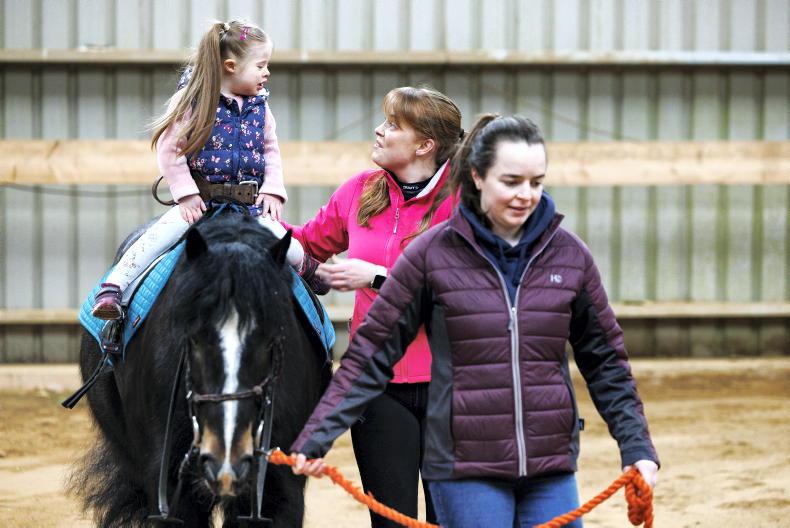
Emma Foley having fun during
hippotherapy with Sarah Beasley and Siobhan Hurley. \ Donal O’Leary
“A horse’s pelvis moves in a three dimensional manner very similar to a human’s pelvis and the movement that’s transmitted from the horse’s pelvis impacts the sensory, cognitive, neuro-motor and musculoskeletal systems of the child,” she explains.
“As therapists, we direct the horse through different movements to impact different systems of the child’s body, helping to regulate and stabilise them. Placing the child in different positions on the horse can help also.”
According to the American Hippotherapy Association that Sarah trained with, hippotherapy has been known to show positive impacts in children with neurological disorders who present with a combination of cognitive, motor and social disabilities.
Making sense of the world
At present, 80% of Strides’ case load involves children with autism who typically have problems processing information coming in from their five senses. They could dislike bright lights or strong smells, “itchy” clothing or being hugged, for example, or may be over or under sensitive to sound.
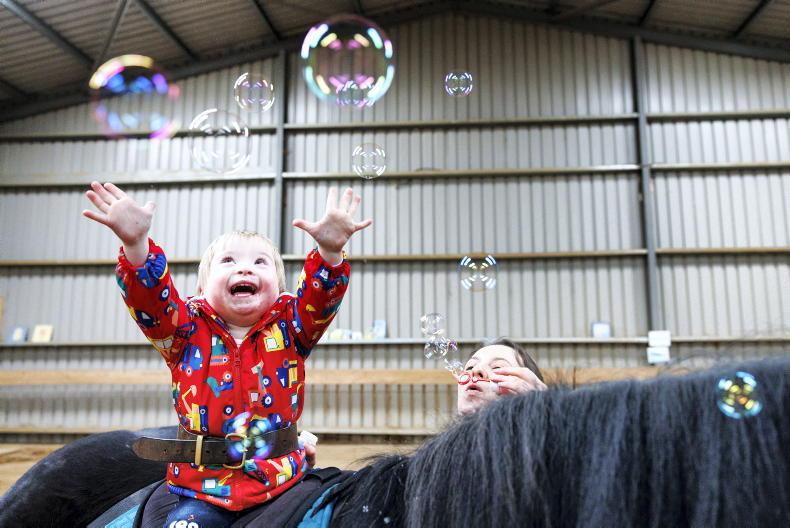
Adam Hayes with occupational therapist Sarah Beasley. \ Donal O’Leary
“The rhythmic, repetitive movement of the horse helps regulate that imbalance,” Sarah explains.
“Some children with autism may also do what we call stimming (flapping their hands) to regulate themselves so that they can process the world around them but getting that movement into them from being on a horse can help with this regulation. This makes it easier for them to engage with the world.”
Goals set
As well as the 12 horses who do three sessions a day each, Sarah works with three horse handlers, a speech and language therapist and two other occupational therapists.
The arena itself is like a giant clinic room with lots of balls, books and games to hand. It is flanked by therapy rooms that you’d see in any other type of clinic. Goals for what the child needs to achieve are set at the beginning of what are usually 12-week courses, with the weekly therapy sessions lasting 50 minutes. Children generally spend between five and 20 of those minutes on a horse, depending on the child.
Puzzles on horseback
“Anything we can do off the horse (therapy wise) we can do on the horse as well,” Sarah adds. “Even having a little shapes board puzzle we can sit that on the horse and the child can do the puzzle there sitting backwards on the horse with the game on the horse’s bum.
“If the child can complete that game while the horse is walking then it’s going to be 100 times easier to complete it when they have to learn to sit at a desk.”
Helps children with Down syndrome
Therapy is available for children with special needs from the ages of one to 12, some of whom have Down Syndrome.
“A lot of children with Downs could be described as having low muscle tone so we would use the horse’s movement to influence different muscle groups to increase the tone.”
She gives an example of how this happens.
“If I was to sit a child backwards on the horse and have them with their hands weight bearing on the rump of the horse we can activate and engage the (child’s) trunk muscles. We can also focus on strengthening the shoulder girdle and the hip girdle to try make it easier for them to engage in motor activities like running, walking or climbing when they are off the horse.”
Games like playing catch may also be part of the therapy session.
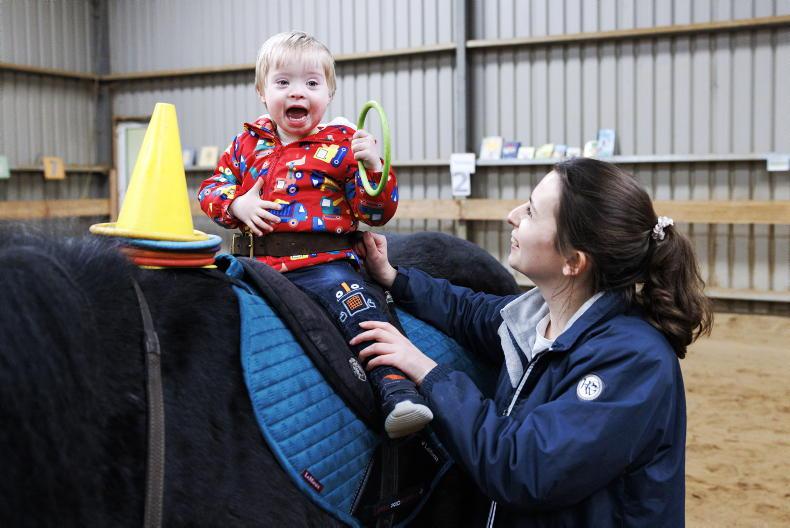
“Children can play catch with the therapist on the ground and the throwing and catching helps them to practice their motor co-ordination and bilateral hand use as the horse is going round. Bubbles are also magic for children and popping them while balancing on the horse helps the child develop their hand-eye coordination.”
Preparation for other therapies
Getting on a horse at the start of a therapy session can be a preparation for other therapy later in the session too.
“Typically it makes it easier for the child to work on functional skills that you’d be doing in a clinic setting. It’s like a readiness, getting them ready to work on, say, their fine motor skills or gross motor skills or their attention span,” Sarah adds.
Fine motor skills relate to upper body skills like picking things up, colouring, fastening buttons or zips. Gross motor skills include being able to climb and jump.
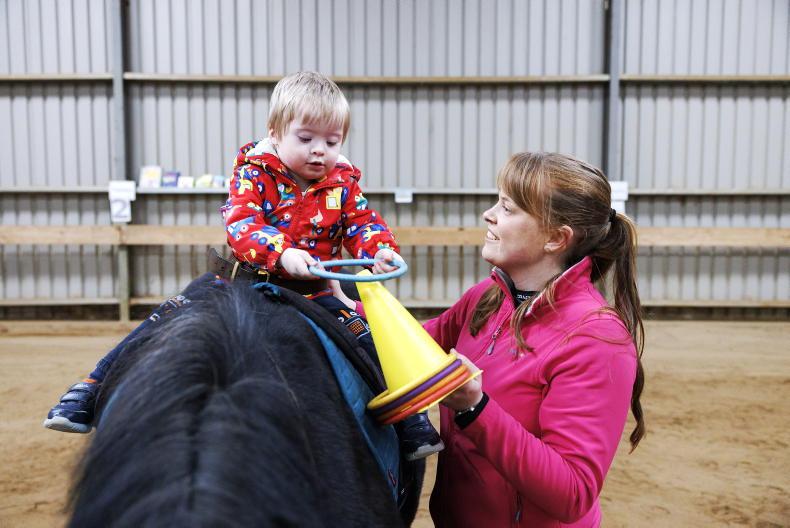
Adam Hayes with occupational therapist Sarah Beasley. \ Donal O’Leary
“Our focus is very much that children become more independent and a lot of that independence is based around play,” she says.
Sarah considers a hippotherapy clinic to be a highly motivating environment. The child wants to feel the movement of the horse and therefore engages more with the tasks in order for that to happen but equine movement also normalises therapy for the child, she believes.
“Some of our children are in mainstream school and they can tell their friends they are going horse riding, something their peers might also be engaging in, so it’s a nice experience for them.”
Sarah’s interest in hippotherapy (hippos is the Greek word for horse) goes back a long way.
“I always wanted to work with horses and children with disability,” she says, “but I never knew how to combine the two until I went to Canada after doing early childhood studies in UCC. After discovering hippotherapy and knowing that I had to be an occupational therapist to do it I completed a Master’s in UL and a week later began my training with the American Hippotherapy Association, first in Barcelona and then in New Mexico.”
‘He has come on in leaps and bounds with the hippotherapy’
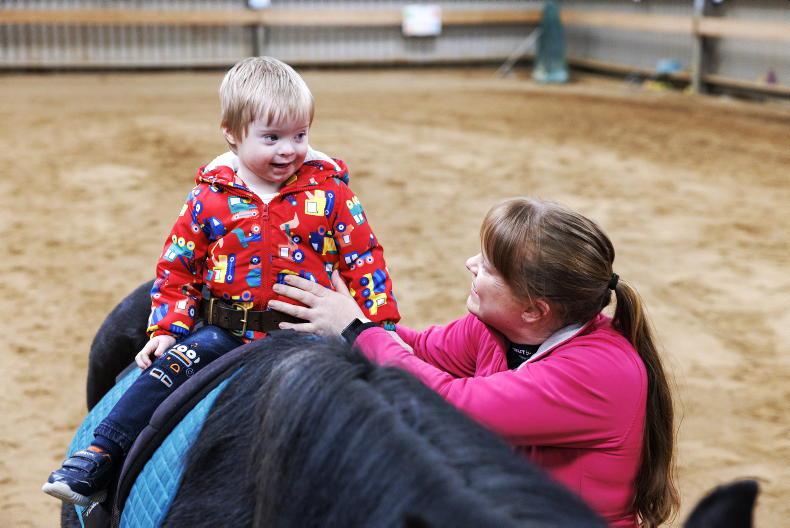
Adam Hayes with occupational therapist Sarah Beasley. \ Donal O’Leary
Elaine O’Brien and her son Adam Hayes are from Carrigaline in Cork. Adam is three years old and has Down Syndrome. After hearing about hippotherapy from a friend last year, Elaine took Adam along to Strides. While he has had physiotherapy, Adam wasn’t always interested in it but Elaine has found that he is improving after having hippotherapy.
“My friend’s son who also has Down Syndrome had come on in leaps and bounds so I said I’d try it,” she says. “You’d try anything. Adam had low muscle tone, he was small, he hated physio, he hated pressure on his legs and wanted to do things his way but he walked last summer, sooner than they thought he would. With COVID, everything had been cancelled so that was very difficult.
“Adam was very wide (walked with legs apart). That was the problem with the low muscle tone, the hypotonia. He has come on in leaps and bounds with the hippotherapy, even his core strength. I found a huge difference in him even weeks into it.
“When I first brought him to Sarah last April he was only bum shuffling and would have been lifted up onto the horse. Initially he would just sit on the horse. The movement helped strengthen his core. He started off with 10 minutes and then that increased. His balance improved an awful lot as well. Now he can stand up on the horse with Sarah holding the belt for support. His confidence has improved a lot as well. He became very sociable after a while too and while he has very few words at the moment he signs “horse” now when we go in the driveway and he runs in. He loves it. The social part of it brought him on as well. We are hoping that the speech will develop more over time too.”
Resources
www.strides.ie
www.americanhippotherapyassociation.org
To watch an American Hippotherapy Association video search “What is
Hippotherapy?” on
YouTube.
Occupational therapist Sarah Beasley stables 12 horses at her Strides Therapy Clinic in Upton, Co Cork, where equine movement is used as a treatment tool in conjunction with occupational and speech and language therapy.
The horses vary in height and gait and Sarah chooses the horse to suit the child.
“Every horse moves slightly differently,” she says. “Some work better for some children so we match the horse with the child’s needs.”
But how exactly does being on the back of a horse help a child with physical or cognitive challenges?

Emma Foley having fun during
hippotherapy with Sarah Beasley and Siobhan Hurley. \ Donal O’Leary
“A horse’s pelvis moves in a three dimensional manner very similar to a human’s pelvis and the movement that’s transmitted from the horse’s pelvis impacts the sensory, cognitive, neuro-motor and musculoskeletal systems of the child,” she explains.
“As therapists, we direct the horse through different movements to impact different systems of the child’s body, helping to regulate and stabilise them. Placing the child in different positions on the horse can help also.”
According to the American Hippotherapy Association that Sarah trained with, hippotherapy has been known to show positive impacts in children with neurological disorders who present with a combination of cognitive, motor and social disabilities.
Making sense of the world
At present, 80% of Strides’ case load involves children with autism who typically have problems processing information coming in from their five senses. They could dislike bright lights or strong smells, “itchy” clothing or being hugged, for example, or may be over or under sensitive to sound.

Adam Hayes with occupational therapist Sarah Beasley. \ Donal O’Leary
“The rhythmic, repetitive movement of the horse helps regulate that imbalance,” Sarah explains.
“Some children with autism may also do what we call stimming (flapping their hands) to regulate themselves so that they can process the world around them but getting that movement into them from being on a horse can help with this regulation. This makes it easier for them to engage with the world.”
Goals set
As well as the 12 horses who do three sessions a day each, Sarah works with three horse handlers, a speech and language therapist and two other occupational therapists.
The arena itself is like a giant clinic room with lots of balls, books and games to hand. It is flanked by therapy rooms that you’d see in any other type of clinic. Goals for what the child needs to achieve are set at the beginning of what are usually 12-week courses, with the weekly therapy sessions lasting 50 minutes. Children generally spend between five and 20 of those minutes on a horse, depending on the child.
Puzzles on horseback
“Anything we can do off the horse (therapy wise) we can do on the horse as well,” Sarah adds. “Even having a little shapes board puzzle we can sit that on the horse and the child can do the puzzle there sitting backwards on the horse with the game on the horse’s bum.
“If the child can complete that game while the horse is walking then it’s going to be 100 times easier to complete it when they have to learn to sit at a desk.”
Helps children with Down syndrome
Therapy is available for children with special needs from the ages of one to 12, some of whom have Down Syndrome.
“A lot of children with Downs could be described as having low muscle tone so we would use the horse’s movement to influence different muscle groups to increase the tone.”
She gives an example of how this happens.
“If I was to sit a child backwards on the horse and have them with their hands weight bearing on the rump of the horse we can activate and engage the (child’s) trunk muscles. We can also focus on strengthening the shoulder girdle and the hip girdle to try make it easier for them to engage in motor activities like running, walking or climbing when they are off the horse.”
Games like playing catch may also be part of the therapy session.

“Children can play catch with the therapist on the ground and the throwing and catching helps them to practice their motor co-ordination and bilateral hand use as the horse is going round. Bubbles are also magic for children and popping them while balancing on the horse helps the child develop their hand-eye coordination.”
Preparation for other therapies
Getting on a horse at the start of a therapy session can be a preparation for other therapy later in the session too.
“Typically it makes it easier for the child to work on functional skills that you’d be doing in a clinic setting. It’s like a readiness, getting them ready to work on, say, their fine motor skills or gross motor skills or their attention span,” Sarah adds.
Fine motor skills relate to upper body skills like picking things up, colouring, fastening buttons or zips. Gross motor skills include being able to climb and jump.

Adam Hayes with occupational therapist Sarah Beasley. \ Donal O’Leary
“Our focus is very much that children become more independent and a lot of that independence is based around play,” she says.
Sarah considers a hippotherapy clinic to be a highly motivating environment. The child wants to feel the movement of the horse and therefore engages more with the tasks in order for that to happen but equine movement also normalises therapy for the child, she believes.
“Some of our children are in mainstream school and they can tell their friends they are going horse riding, something their peers might also be engaging in, so it’s a nice experience for them.”
Sarah’s interest in hippotherapy (hippos is the Greek word for horse) goes back a long way.
“I always wanted to work with horses and children with disability,” she says, “but I never knew how to combine the two until I went to Canada after doing early childhood studies in UCC. After discovering hippotherapy and knowing that I had to be an occupational therapist to do it I completed a Master’s in UL and a week later began my training with the American Hippotherapy Association, first in Barcelona and then in New Mexico.”
‘He has come on in leaps and bounds with the hippotherapy’

Adam Hayes with occupational therapist Sarah Beasley. \ Donal O’Leary
Elaine O’Brien and her son Adam Hayes are from Carrigaline in Cork. Adam is three years old and has Down Syndrome. After hearing about hippotherapy from a friend last year, Elaine took Adam along to Strides. While he has had physiotherapy, Adam wasn’t always interested in it but Elaine has found that he is improving after having hippotherapy.
“My friend’s son who also has Down Syndrome had come on in leaps and bounds so I said I’d try it,” she says. “You’d try anything. Adam had low muscle tone, he was small, he hated physio, he hated pressure on his legs and wanted to do things his way but he walked last summer, sooner than they thought he would. With COVID, everything had been cancelled so that was very difficult.
“Adam was very wide (walked with legs apart). That was the problem with the low muscle tone, the hypotonia. He has come on in leaps and bounds with the hippotherapy, even his core strength. I found a huge difference in him even weeks into it.
“When I first brought him to Sarah last April he was only bum shuffling and would have been lifted up onto the horse. Initially he would just sit on the horse. The movement helped strengthen his core. He started off with 10 minutes and then that increased. His balance improved an awful lot as well. Now he can stand up on the horse with Sarah holding the belt for support. His confidence has improved a lot as well. He became very sociable after a while too and while he has very few words at the moment he signs “horse” now when we go in the driveway and he runs in. He loves it. The social part of it brought him on as well. We are hoping that the speech will develop more over time too.”
Resources
www.strides.ie
www.americanhippotherapyassociation.org
To watch an American Hippotherapy Association video search “What is
Hippotherapy?” on
YouTube.











 This is a subscriber-only article
This is a subscriber-only article











SHARING OPTIONS: